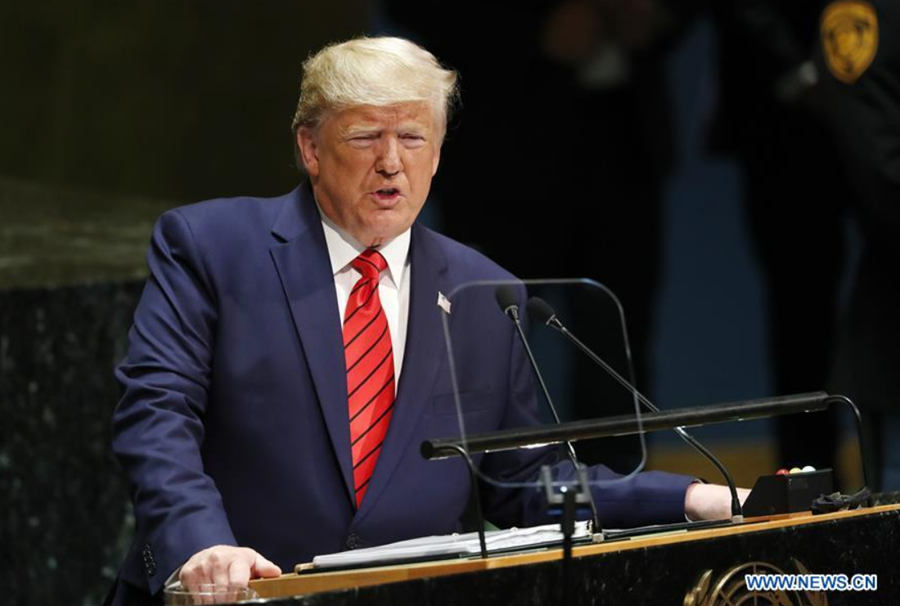


U.S. President Donald Trump addresses the General Debate of the 74th session of the UN General Assembly at the UN headquarters in New York, on Sept. 24, 2019. (Xinhua/Li Muzi)
US President Donald Trump delivered his third address to the UN General Assembly on Tuesday, Sept. 24, spending about six minutes of his speech attacking China on trade issues and Hong Kong. His speech is another example of Trump “gaming” the facts to fit his narrative about the rise of China.
Trump’s “America First” speech was widely deemed as a nationalist speech with low-energy delivery.
Trump’s criticism about America’s economic ties with China is nothing new. In his speech, Trump labeled the US decision for China’s accession to the WTO in 2001 a mistake, saying it failed to change China’s development path in the way that the United States had hoped, and he accused China of embracing an economic model that seeks to “game” the international trading system.
Trump also blamed China for the loss of 60,000 factories in America—a claim he has made before, too. While many American companies did (and still do) invest in China, and there is huge trade deficit between the two largest economies in the world, this is the result of rational economic behavior by both countries’’ producers and consumers and is driven largely by market forces.
Therefore, it is a stretch of the imagination to say that all of the hollowing out of US manufacturing is due to China’s rise.
A lie told a thousand times does not become truth. The model that China has embraced values globalization, reform, and opening to the world. China plays by the rules of the WTO and other international multilateral organizations, which were mostly designed by the West.
Trump’s harsh criticism also ignored the role that the Chinese people and its government have played in making China great again. China’s achievements derive from the hard work of the Chinese people and the strong leadership of the Communist Party of China, and sweat and even tears are behind China’s rise to greatness.
Trump also used the moment to throw support behind the protestors in Hong Kong, challenging the One China principle—a cornerstone of the China-US relationship. The US is encouraging radical protesters to use more extreme acts to drive a wedge between the Chinese people.
Trump’s comments were an interference in Hong Kong’s affairs, which goes against international norms, as Hong Kong is part of China. China has urged foreign countries to stop endorsing Hong Kong’s violent and radical forces and stop abetting them to harm the prosperity of the special administrative region.
Chinese Foreign Minister Wang Yi recently said in a speech that recognition of and respect for disparities are the anchor for real harmony. We should understand that China and the United States are different. They have different histories, different cultures, different political systems, and different development path. The key to harmony is how to correctly understand and handle them.
Blaming China might help win a few votes, but it will not solve America’s problems. If Trump is serious about fixing America, instead of trying to bully China and other countries, he should try harder to understand and handle differences. China has no intention to play “game of thrones” on the world stage and it is not in America’s national interest to challenge China. The best way forward, for both sides, is to work together for greater China-US cooperation.

 Award-winning photos show poverty reduction achievements in NE China's Jilin province
Award-winning photos show poverty reduction achievements in NE China's Jilin province People dance to greet advent of New Year in Ameiqituo Town, Guizhou
People dance to greet advent of New Year in Ameiqituo Town, Guizhou Fire brigade in Shanghai holds group wedding
Fire brigade in Shanghai holds group wedding Tourists enjoy ice sculptures in Datan Town, north China
Tourists enjoy ice sculptures in Datan Town, north China Sunset scenery of Dayan Pagoda in Xi'an
Sunset scenery of Dayan Pagoda in Xi'an Tourists have fun at scenic spot in Nanlong Town, NW China
Tourists have fun at scenic spot in Nanlong Town, NW China Harbin attracts tourists by making best use of ice in winter
Harbin attracts tourists by making best use of ice in winter In pics: FIS Alpine Ski Women's World Cup Slalom
In pics: FIS Alpine Ski Women's World Cup Slalom Black-necked cranes rest at reservoir in Lhunzhub County, Lhasa
Black-necked cranes rest at reservoir in Lhunzhub County, Lhasa China's FAST telescope will be available to foreign scientists in April
China's FAST telescope will be available to foreign scientists in April